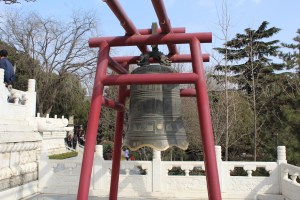So I saw a whole bunch of historical sites while in Xi’an, and while the Terracotta Warriors were certainly at the top of the list this one was definitely a significant place that I simply had to take a minute to talk about.
Built in 652 AD (during the Tang Dynasty), the Pagoda was built by the Emperor to honor his mother who had “helped him achieve his position” as crown prince and then Emperor. My tour guide thought of it as a very sweet remembrance of an Emperor to his beloved mother.

But let’s hold on there for just one tick.
An Emperor has a large number of wives and concubines, all of whom produce multiple offspring. The ascension rights to the throne is not a clean or peaceful one – it tends to involve a great deal of wheeling and dealing not to mention death. Afterall, any one of those sons can claim right to the throne, and the most effective way to clear a path for a child to the throne is to kill the others in line before and even behind him.
So basically, this place was built to honor a mother who… Well, you get the picture. The Queen Mother was NOT someone to eff with. *



I heard later that the Pagoda collapsed some fifty years after being built, but considering who built it to begin with and the reasons why, it was rebuilt, and continues to stand today.
However, you can see that it is beginning to tilt just a bit to the left. It is something the government has been keeping an eye on, and continue to do repairs as needed.
Please notice the seven stories to the Pagoda. Odd numbers were considered lucky in China, and the number ‘9’ has always been attributed to the Emperor himself. As the Emperor at the time was trying to honor his mother, he built the Pagoda 7 stories high, still a lucky number, second only to the Emperor himself.** Talk about love.
And here I can barely get my kid to respond my text messages… Clearly, I’m doing something wrong.



Buddhism was heavily practiced throughout the Empire (and still is). A Chinese Buddhist monk traveled to India to learn directly from the masters there, and returned with 657 sutras outlining the Buddhist faith directly from the homeland of said religion. I was told by my tour guide that, because of the loving story of why this Pagoda was built – the pure love of a son for his mother – he chose this Pagoda to store the manuscripts he was able to obtain. The monks present began doing the translations, and kept a library there on site. ***


Please note, one of the reasons why this site was so popular when I visited was that they still actively practice Buddhism here, with monks living here and offering prayers and blessings. The library (pictured above) is still present, but it is no longer open to the general populace – too many people were writing or highlighting the texts.



So why “large wild goose”?
Yeah, I asked that one, too. Doesn’t exactly roll off the tongue, does it?
Throughout China, there were many different sects of Buddhism. While most of them had changed to be primarily vegetarian, this one had not. During a particularly brutal winter, the monks at this Pagoda had run out of food and were beginning to starve. They prayed and prayed to Buddha to help see them through, to give them a sign.
According to local lore, that was when a flock of geese were flying overhead, and one dropped dead in the courtyard as the monks were finishing their prayers. They saw this as a sign to change their ways, and converted to vegetarian as had many of the other monasteries in the region had. ****



Despite the crowds of this place, there was still a peaceful quality to it all. Likely because this was still a place of worship. Buddha takes a number of different forms, and at the base of the Pagoda, each form had a prayer room dedicated solely to it. People moved from room to room, taking a few moments to offer a prayer, some finding the monks to divest blessings upon them. Others were simply taking in the beauty of the art to be found here.



* I am not saying that this type of thing is unique to China! Kingdoms all over the world have gone through the exact same thing as far as claiming rights to the throne.
** I read other places that, originally, the Pagoda was originally only 5 stories tall, the extra two layers added later. My tour guide had told me 7 and with the above story.
*** According to the info I found, the monk in question – Xuanzang – had actually returned from India several years before the Pagoda was completed, and only later decided to store the manuscripts there.
**** This was the story according to my tour guide, and I could not find any information to collaborate or deny the story. Seemed a pretty tale.